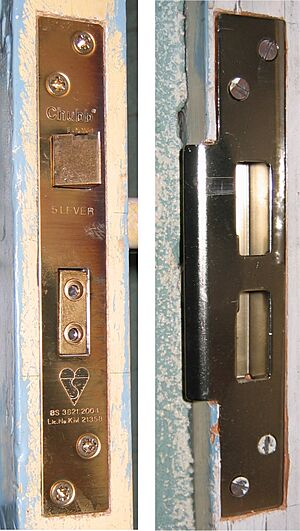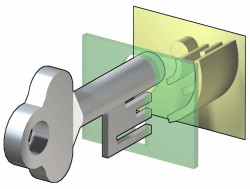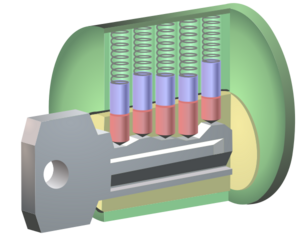Mortise lock facts for kids
A mortise lock is a special type of lock. It's different because it fits into a deep pocket cut into the edge of a door or piece of furniture. This pocket is called a "mortise." You'll often find these locks on older buildings. But they are also used in newer, fancy homes and businesses. They are very common in homes across Europe.
Contents
The Story of Mortise Locks
Mortise locks have been used in the United States since the early 1700s. At first, you would pull a handle to open a door with this type of lock. Later, door knobs became popular instead of pulls.
Early Use and Other Locks
For a long time, mortise locks were only found in the most important rooms of expensive houses. Other rooms used "box locks" or "rim locks." Unlike mortise locks, rim locks sit on the surface of the door. They don't fit inside a pocket. Rim locks have been used in the U.S. since the early 1700s too.
An interesting example is at Thomas Jefferson's home, Monticello. In 1805, Jefferson ordered many locks for his house. He chose rim locks for closets. But he ordered 26 mortise locks for the main rooms. This shows how special mortise locks were considered.
Even though pictures of mortise lock parts were in catalogs, they were still expensive. They were also hard to get. Jefferson had to order his locks all the way from Paris!
How Warded Locks Work
The mortise locks at Monticello were "warded locks." The term "warded lock" describes how the inside of the lock works. The term "mortise lock" describes where the lock is placed in the door. Warded locks have special metal pieces inside called "wards." Only a key with the right cuts can fit past these wards and turn to open the lock.
Warded locks were used in Europe for a very long time, up until the early 1800s.
The Rise of Lever Tumbler Locks
Three English locksmiths helped create more modern locks. These were Robert Barron, Joseph Bramah, and Jeremiah Chubb. Chubb patented his "lever tumbler lock" in 1818.
Again, "lever tumbler lock" tells you about the lock's inner workings. So, a lock can be both a mortise lock and a lever tumbler lock. In these locks, the key moves a series of levers. This allows the bolt to slide and open the door.
Pin Tumbler Locks: A Big Change
A major improvement for mortise locks came in 1865. Linus Yale, Jr. invented the "pin tumbler mortise cylinder lock." Before this, the main part of the lock was always on the outside of the door. Yale's invention put the pins and the lock's working parts inside the door too.
This change meant keys could be much shorter. They didn't need to reach all the way through the door anymore. Pin tumbler locks are still the most common type of mortise lock used today.
How a Mortise Lock Works
Mortise locks can have a spring-loaded latch that opens with a door handle. This type is called a sash lock. A simpler version without a handle or latch is called a dead lock. Dead locks are often used as an extra secure lock, usually with another lock that has a spring latch.
Historically, and even today, many mortise locks use "lever lock" mechanisms. Older ones might have used "warded lock" mechanisms. In Europe, a type called the "Euro cylinder" lock is now common. It uses a "pin tumbler lock" inside a mortise casing.
Key Parts of a Mortise Lock
A typical mortise lock setup in the U.S. includes several parts:
- The lock body: This is the main part that fits inside the mortise cut-out in the door.
- The lock trim: These are the parts you see on the outside of the door. They can be doorknobs, levers, or fancy handle sets.
- A strike plate (or box keep): This metal plate lines the hole in the door frame. The lock's bolt slides into this hole when the door is closed.
- The keyed cylinder: This is where you put the key. It controls the locking and unlocking of the lock body.
Choosing and Installing a Mortise Lock
Installing a mortise lock can be done by someone who knows basic woodworking. Many professional carpenters use a special tool called a "mortising jig." This tool helps them cut the pocket in the door very precisely. But even with the jig, putting on the outside parts can be tricky for someone new to it.
Even though cutting a hole for a mortise lock can make a wooden door a bit weaker, the lock itself is usually stronger. It's also more flexible than newer "bored cylindrical locks." Mortise locks can handle heavier door knobs and stronger inner parts. They are used in many places, like factories, businesses, and schools, because they are very secure.
Also, most mortise locks can use different cylinders and parts from other companies. This means they can match other locks already in a building.
Many companies make mortise locks in the United States. Some well-known names include Accurate, Arrow, Baldwin, Best, Corbin Russwin, Emtek Products, Inc, Falcon, Penn, Schlage, Sargent, and Yale. You can also find many decorative parts to make the locks look nice. European manufacturers are also becoming more popular.





